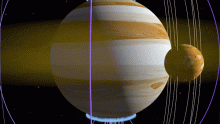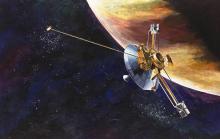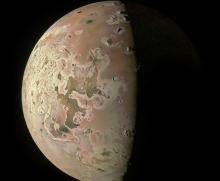Listen to today's episode of StarDate on the web the same day it airs in high-quality streaming audio without any extra ads or announcements. Choose a $8 one-month pass, or listen every day for a year for just $30.
You are here
Moon and Jupiter
Jupiter is the beachball of the solar system: big, round, and painted with colorful stripes. It’s also the largest planet in the solar system, so each stripe is thousands of miles wide.
The stripes are created by Jupiter’s high-speed rotation — it spins on its axis once every 10 hours. They’re separated by jet streams that blow at hundreds of miles per hour and dip a couple of thousand miles into the atmosphere. And their borders can be turbulent, marked by ripples and waves as big as countries.
The bands alternate between light-colored zones and darker belts. The clouds in the zones are higher, while those in the belts are lower, allowing us to see deeper into Jupiter’s atmosphere. The clouds are made of ammonia and other compounds, with clouds of water below.
The bands are colored in shades of yellow, red, and brown, giving Jupiter its beachball appearance. The color may come from compounds of sulfur, phosphorus, and other elements dredged from deep below.
Giant storms float through the bands. The biggest is the Great Red Spot, which is the size of Earth — a colorful decoration for a colorful beachball.
Look for Jupiter to the upper left of the Moon this evening. It looks like a brilliant star — only the Moon and the planet Venus outshine it. And if you can’t catch them tonight, Jupiter and the Moon will be about the same distance apart tomorrow night, with Jupiter to the right of the Moon.
Script by Damond Benningfield






